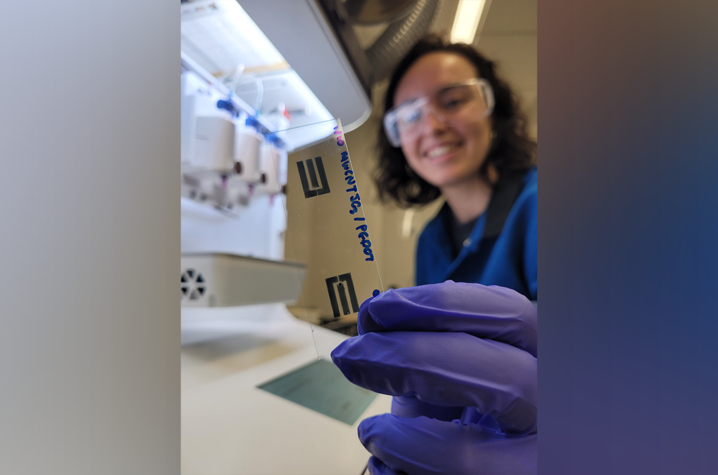Provost IMPACT Award: Bridging biology and electronics

LEXINGTON, Ky. (May 1, 2025) — Last fall, the University of Kentucky Office of the Provost announced the second cohort of the Institutional Multidisciplinary Paradigm to Accelerate Collaboration and Transformation (IMPACT) Awards winners.
The IMPACT Awards initiative, an internal funding program from the Office of the Provost, launched in 2023 to support innovation and transformation within UK’s colleges. The awards recognize the groundbreaking work conducted by faculty and staff across campus, and they create opportunities for transdisciplinary collaboration to occur between UK community members to help the university’s mission of advancing Kentucky.
Fifteen colleges, including UK Libraries and The Graduate School, are working collectively to break new ground on ways to advance Kentucky.
This spring, UKNow is highlighting the 2024-25 IMPACT Award projects and the faculty who are leading them. Today, we learn more about the project titled “Synthetically Tunable Organic Mixed Ionic-Electronic Conductors for Printed Bioelectronics.”
Organic Mixed Ionic-Electronic Conductors (OMIECs) convert the movement of ions, which are a key signaling pathway in biological systems, into the movement of electrons, which are easily read by modern computers. The ability to transduce biological signals into electronic signals will have tremendous impact on medical diagnostics and therapies, the human-machine interface and the design of prosthetic limbs. In recognition of the importance of this emerging technology, UK recently established the UK Bioelectronics and Nanomedicine Research Center (BNRC), which is a campus resource for scientists working in this promising new area. While the center is well stocked with equipment, including a multimode printer, currently OMIECs which can be printed are not commonly available.
As the focus of this IMPACT project, Alexandra Paterson, Ph.D., assistant professor of materials engineering, and John Anthony, Ph.D., professor of chemistry — both researchers at the UK Center for Applied Energy Research (CAER) — are collaborating to develop printable OMIEC inks for use by center researchers. The availability of a plug-in set of materials and formulations optimized for use in BNRC equipment will accelerate the adoption of this emerging technology, spurring innovative new applications in bioelectronics.
Additional team members include Matthew Weisenberger, Ph.D., adjunct assistant professor of materials engineering, associate director of CAER's Carbon Materials Research Group and full-time researcher at CAER; Karl Thorley, Ph.D., research scientist at CAER; and Paula Alarcon-Espejo, graduate research assistant at CAER.
UKNow sat down with the team to learn more about the project. You can read more in the Q&A session below.
How has the IMPACT award inspired innovation at UK with your research?
John Anthony’s research team has decades of experience in optimizing molecules for electronic transport, for use in flexible electronics, power generation and high-resolution displays, but until now had never explored how to tune these materials to also transport ions. Select members of the research team had to perform extensive research and then develop novel synthetic routes to generate completely new classes of materials for use as OMIECs. The effort was complicated by the fact that most modern OMIECs are based on polymers — which are efficient but can be difficult to print. Tuning molecular systems to perform similarly has been a daunting task. Similarly, the Paterson group has significant expertise in the generation of bioelectronic transistors from polymeric systems but has not worked with molecular systems in this area, and her team has also had to explore the capabilities of the BNRC’s printing equipment. Her team has also had to develop appropriate printable electrode formulations and configurations, with a particular focus on quality and reproducibility. Creating and optimizing the total process for forming transistor devices from new OMIECs requires constant feedback between the two research groups, and biweekly collaborative all-participant meetings help to keep everyone on track.
How did you decide on this particular topic or research area?
When the BNRC was established, we saw the need for a source of materials to go with the center’s equipment to provide users with a ‘plug and play’ approach to generate transistors from OMIECs for use in bioelectronics applications.
What positive impact will your research have on Kentucky and beyond?
Electronic devices based on OMIECs have demonstrated potential across a wide array of health applications, ranging from low-cost, compact glucose monitors to neural interfaces. By developing a reliable formulation for printing OMIECs, researchers at UK will be able use these new device types as components of their own research projects. Societal implications in Kentucky include OMIEC and organic electrochemical transistor (OECT) technologies that will support the economy, promote higher standards of living and better medical treatment, through low-cost biosensors for remote health care, to agricultural sensing applications.
What comes next for your research?
In this application area, Professor Paterson and Professor Anthony will use the outcomes of this project to pursue further funding in the development of high-performance OMIECs for bioelectronics applications.
As the state’s flagship, land-grant institution, the University of Kentucky exists to advance the Commonwealth. We do that by preparing the next generation of leaders — placing students at the heart of everything we do — and transforming the lives of Kentuckians through education, research and creative work, service and health care. We pride ourselves on being a catalyst for breakthroughs and a force for healing, a place where ingenuity unfolds. It's all made possible by our people — visionaries, disruptors and pioneers — who make up 200 academic programs, a $476.5 million research and development enterprise and a world-class medical center, all on one campus.




